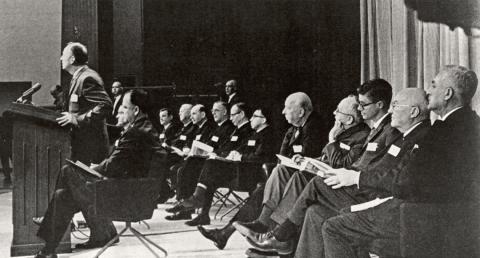Historic Public Health Report Marks 60th Anniversary

Smoking and Health: Report of the Advisory Committee to the Surgeon General, published 60 years ago in January 1964, reshaped the way Americans viewed smoking. As the scientific foundation of a highly effective public health campaign, it provided a new model for changing individual behavior.
Smoking had become wildly popular in the first half of the 20th century, even as epidemiologists and pathologists demonstrated its connections with lung cancer and other deadly diseases. The scientific results were taken up by nonprofit advocates such as the American Cancer Society, American Heart Association and the National Tuberculosis Association, precursor to the American Lung Association. But tobacco companies publicly dismissed the then-novel research as inconclusive and, as more American households bought televisions, the industry stepped up its pro-smoking advertising campaigns.
In 1956, Surgeon General (SG) Leroy Burney convened a year-long study group to review the available research. That review confirmed the causal relationship between smoking and lung cancer, which Burney then announced as the official opinion of the U.S. Public Health Service (PHS).
The tobacco industry aggressively questioned PHS’s interpretation of the data, and Burney issued a still-stronger statement in 1959.
Yet U.S. smoking rates continued to rise: By 1960, more than 40% of adult Americans reported actively smoking. The public health challenge was thus to convince Americans to make decisions about whether to smoke—or quit—in light of sound scientific evidence.

Photo: NLM
Burney’s successor, SG Luther Terry, convened a second study group in November 1962. This time, members were asked to prepare a formal report for publication.
Terry’s committee worked for just over a year, without fanfare, meeting mostly in offices in the basement of NIH’s brand-new National Library of Medicine (NLM) building (see sidebar).
NLM staff helped compile more than 7,000 publications, including many studies conducted at or funded by NIH.
In the five years since Burney’s press conference, new research had directly linked smoking tobacco with several other deadly diseases that were already rising health concerns.
Taken together, the effects of smoking produced a 70% increase in mortality over nonsmokers, and smokers had been found to face a 10- to 20-fold increase in the risk of death from lung cancer—although quitting was shown to substantially improve the odds. Scientists had also determined that women who smoked while pregnant had babies with significantly lower birth weights.

Photo: courtesy don shopland
Terry presented the report’s highlights in a press conference on Jan. 11, 1964, prompting shocked stories in newspapers and TV programs across the U.S. and abroad. Catchy public service announcements soon followed.
In 1965, Congress stepped in with the Federal Cigarette Labeling and Advertising Act, compelling U.S. tobacco companies to print health warnings directly on cigarette packets and requiring the SG’s office to produce annual reports on smoking and health, thereby ensuring attention to emerging questions such as health consequences for women (1980), nicotine addiction (1988), effects by race and ethnicity (1998), effects of secondhand smoke (1986, 2006, 2010) and risks of e-cigarettes (2018). In 1969, legislators passed the Public Health Cigarette Smoking Act to prohibit cigarette advertising via television and radio.
The 1964 Report on Smoking and Health thus left an admirable legacy. While smoking is still a leading cause of preventable death, U.S. rates now hover at an all-time low of about 11%. Youth smoking, which peaked at 36.4% in the late 1990s, is currently less than 2%.
Read more about the historic report online at https://go.nih.gov/QZJbehf.


